Biography
Interests
Wei Xu1,2,3*, Yongzhao Xiong1, Mengru Liu1, Xiaoxiao Wang1, Mengge Song1
1College of Life Science, Xinyang Normal University, Xinyang, 464000, China
2Tea Plant Biology Key Laboratory of Henan Province, Xinyang, 464000, China
3Institute for Conservation and Utilization of Agro-bioresources in Dabie Mountains, Xinyang, 464000, China
*Correspondence to: Dr. Wei Xu, College of Life Science, Xinyang Normal University, Xinyang, China.
Copyright © 2018 Dr. Wei Xu, et al. This is an open access article distributed under the Creative Commons Attribution License, which permits unrestricted use, distribution, and reproduction in any medium, provided the original work is properly cited.
Abstract
Soluble green tea powder (SGTP) has the functional properties of antioxidation and antibacterial. In this paper, SGTP was used as the aqueous phase to prepare tea tree seed oil nanoemulsion by low energy method. The effect of SGTP on tea tree seed nanoemulsion was studied by measuring the average particle diameter and light transmittance. And the total antioxidant capacity and antibacterial ability of the tea tree seed oil nanoemulsion were also examined. The experimental results show that the SGTP can reduce the particle size of the tea tree seed oil nanoemulsion. With the increase of the content of SGTP, the antioxidant capacity of the tea tree seed oil nanoemulsion is gradually improved, and the ability to inhibit Escherichia coli and Staphylococcus aureus is further enhanced. Therefore, SGTP play a good role in the tea tree seed oil nanoemulsion, and may broaden its application in functional food, medical field and scientific research.
Introduction
Nanoscale emulsion is an emulsion system with a particle size between 50-500nm, a stable system formed by a certain proportion of water, surfactant and oil [1-3]. Tea tree seed oil, rich in unsaturated fatty acids, its nanoscale emulsion is being reached more and more attention, and has been widely used in food, medicine and other fields. Especially in the part to develop functional food sand lipid replacement [4,5]. At present, there are many reports on the research of oil nanoemulsion, such as sun-flower seed oil, ginger oil and soybean oil [6-8]. However, there relatively few reports on tea tree seed oil, especially for tea tree seed oil nanoemulsion.
Soluble green tea powder (SGTP) is prepared by crushing green tea into ultrafine oxalic powder which ensure its original natural nutrients of green tea and soluble in water [9,10]. SGTP is rich in functional ingredients, such as tea polyphenols, amino acids, caffeine, vitamins, carotene and so on [11]. It has been proved that SGTP can relieve fatigue, prevent fat accumulation in the body, promote digestion and cure constipation [12,13]. Therefore, it has been widely used in food, cosmetics and medical fields.
Based on the antioxidant and bacteriostatic of SGTP [14], tea tree seed oil/SGTP nanoemulsion is prepared as a kind of functional food ingredient which can provide abundant unsaturated fatty acids. Because the size of nanoemulsion has strong effect on its stability, digestion behavior and functional performance [15]. Therefore, in this study, the tea tree seed oil/water nanoemulsion was prepared by low-energy method, and the effect of different green tea powder contents on the particle size, stability, antioxidant capacity and bacteriostatic ability of tea tree seed oil nanoemulsion was studied. This endeavor provides a technical reference for the application of SGTP and tea tree seed oil in food industry.
Materials and Methods
Soluble green tea powder (SGTP) (moisture 3.3%, tea polyphenol 52%, and caffeine 7.4%) was purchased
from Shanghai source biological technology co., LTD. Tea tree seed oil was obtain organic wild camellia and
provided friendly by Jiangxi Chunyuan green food co. LTD (Jiangxi, China). Tween 80, Span 80 and sodium
benzoate were purchased from Sinopharm Chemical Reagent Co. Ltd. Other chemicals were reagent grade
and used without further purification. Other chemical reagents of analytical grade were purchased from
commercial sources in China and used without further purification. All the solutions used in the experiment
were prepared using ultrapure water through a Millipore (Millipore, Milford, MA, USA) Milli-Q water
purification system.
Weighing Tween 80 and Span 80 (9:1) in small bottles, stir evenly on magnetic stirrer at room temperature
(40 min). Then add the tea tree seed oil and stir at room temperature for 20 min. And then deionized water
was added into and mixed well. The final concentration of tea tree seed oil in nanoemulsion was 1%, 2%,
4% and 8% respectively, green tea powder solutions were 0.1%, 0.25%, 0.75%, 1%, 2% and 4% respectively.
The particle sizes of tea tree seed oil nanoemulsion were determined using the dynamic laser scattering
technique. The tea tree seed oil nanoemulsion samples with different green tea powder content were diluted
100 times in advance with distilled water. The particle size of the above nanoscale emulsion was measured by
laser particle size analyzer at 25°C. The transmittance of ultraviolet visible spectrophotometer was measured
at 600nm. Each sample was measured for 3 times.
Test kit for the total antioxidant capacity (T-AOC, Nanjing Jiancheng Bioengineering Institute, China)
was used to determine the antioxidant capacity of green tea powder tea tree seed oil nanoemulsion. Tea tree
seed oil nanoemulsion samples prepared with 1mL oil content were taken into the test tube, and then mixed
with the specified amount of reagent in the measuring tube and the contrast tube. The absorption values
were measured at 520nm. The antioxidant capacity was then calculated.
Total antioxidant capacity (U/ml)= [ (At-Ac)/ (0.01×30)] ×M×m
In which at was the absorption values of nanoemulsion, Ac was the absorption values of control, M was the dilution ratio of reaction system, and m was the dilution ratio of nanoemulsion.
The inhibitory zone of tea tree seed oil/SGTP nanoemulsion was determined investigated using disk diffusion
method [16,17]. Briefly, the Gram- negative Escherichia coli and Gram-positive Staphyloccocus aureus were
taken as two typical pathogenic bacteria. The overnight cultured Escherichia coli and Staphyloccocus aureus,
were coated on agar plate medium. Filter paper discs (6mm diameter) were soaked with tea tree seed oil/
SGTP nanoemulsion solution for 15min, and then placed on the inoculated plates. The diameters of the inhibition zones were measured by vernier caliper after incubating at 37°C for 24 h.
Results and Discussion
It can be seen from Figure 1 that in the tea tree seed oil nanoemulsion with different oil content above, tea
oil nanoemulsion with 1% oil content is transparent in appearance with an average particle size of 100nm.
The average particle size was the smallest in the four different oil contents nanoemulsion. The other three tea
oil nanoemulsions with different oil content are milky white in appearance with an average particle size of
more than 100nm. Obviously, tea tree seed oil emulsion was a thermodynamic stability system. The average
particle size of 2% tea tree seed oil oil nanoemulsion was 210nm. The reason may be the low absorption rate
of surface active components.
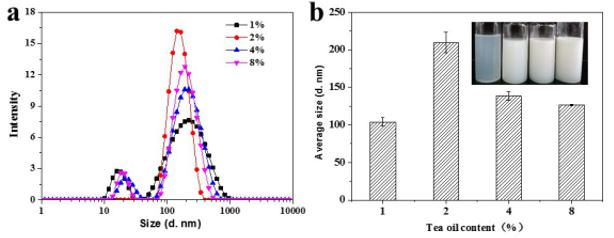
As you can see from Figure 2, when the oil and the SGTP content was 1% and 0.1%, the average particle
size of the tea tree seed oil oil nanoemulsion was 100nm. With the increase of SGTP mass fraction, the
average particle size of tea tree seed oil nanoemulsion increased. The higher the average particle size of tea
tree seed oil nanoemulsion, the worse its stability was. It indicated that the addition of SGTP reduced the
stability of tea tree seed oil nanoemulsion. Fig. 2b showed that the average particle size of stable tea oil
nanoemulsion with 0.25% SGTP was 150nm.
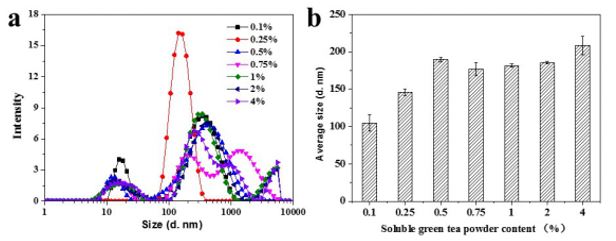
The transmittance of tea tree seed oil nanoemulsion with different green tea powder quality scores (0%-4%)
was measured, and the results were shown in Fig 3. The results showed that when the oil content was 1%,
the transmittance of tea tree seed oil nanoemulsion decreased gradually with the increase of SGTP fraction.
When SGTP content reached 0.75%, the tea tree seed oil nanoemulsion began to appear unstable. The
phenomenon of flocculent precipitation was observed with the increase of SGTP. The results show that the
addition of SGTP influenced the stability of tea tree seed oil nanoemulsion and reduces the stability of tea
tree seed oil nanoemulsion.
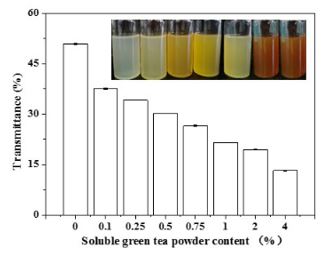
As Fig. 4 showed, the total antioxidant capacity of tea tree seed oil nanoemulsion containing 0.5% SGTP
is slightly reduced when the oil content is 1%. But when the SGTP increased from 1% to 4%, the total
antioxidant capacity of tea tree seed oil nanoemulsion began to increase steadily. The results illustrated that
adding SGTP could improve the antioxidant capacity of tea tree seed oil nanoemulsion. The main contributor
to improve antioxidant capacity maybe some functional substances with antioxidant capacity in green tea
powder, including polysaccharides, polyphenols, and so on [18]. It has been reported that tea polyphenols
have strong antioxidant and scavenging free radicals. It is a natural and efficient free radical scavenger and
can inhibit lipid oxidation. Therefore, the preparation of tea tree seed oil/SGTP nanoemulsion could play
the physiological function of various functional components in SGTP. Meanwhile it can also improve the
lipid stability of tea tree seed oil and improve the comprehensive functional characteristics of the food
ingredients.
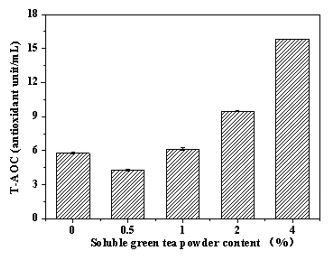
The antibacterial properties of tea tree seed oil nanoemulsion with different SGTP content on Escherichia coli
are shown in Fig. 5. It can be clearly seen from the results that the ability of tea tree seed oil nanoemulsion
to inhibit Escherichia coli was very weak. While when the addition of SGTP was 2%, the inhibition zone
was about 8.1±1.8mm. When SGTP was 4%, its inhibition zone increased to 11.3 + 1.2mm. Therefore,
improving the content of SGTP could improve the ability of tea oil nanoemulsion to antibacterial Escherichia coli. The phenomenon may resulted from the soluble polysaccharides and polyphenols in soluble tea powder
which have been confirmed that have strong antibacterial properties. These active constituent can bind
to the membrane of Escherichia coli, especially for protein substances and change the permeability of cell
membrane. The nano effect of nanoemulsion makes it have high permeability which could easily reach
directly into the cell and bind to DNA and enzymes, thus accelerating the death of Escherichia coli. The Fig.
5 demonstrated that the tea tree seed oil/SGTP nanoemulsion could apply to food preservation and storage
process, and have potential to improve the shelf life of food [19].
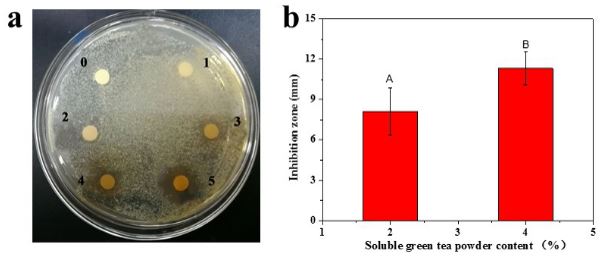
As shown in Fig. 6, the effect of tea tree seed oil/SGTP nanoemulsion with 4% SGTP on the inhibition of
Staphylococcus aureus is more obvious than that with 2% SGTP. The increasing antibacterial property with
increased SGTP content may result from the separation of the cell wall of Staphylococcus aureus from the
cell membrane, which further lead to the DNA molecules concentrate into a tense state and lose the ability
to replicate. Therefore, tea tree seed oil/SGPT nanoemulsion has good inhibition of Escherichia coli and
Staphylococcus aureus from Fig.5 and Fig.6. That means SGPT endow the nanoemulsion a broad-spectrum
ability to inhibit the pathogenic microorganism of food, especially for SGPT riched tea tree seed oil
nanoemulsion. It noted that tea tree seed oil/SGPT nanoemulsion had higher bacteriostatic characteristics
to staphylococcus aureus, which mean the nanoemulsion had higher ability to inhibit gram-positive bacteria.
This phenomenon is consistent with that of silver nanoparticles reduced using SGPT. This may related to
the higher binding capacity of the functional molecules in SGPT with gram-positive bacteria, which lead
higher destructive capacity to cell membrane of microorganism [20]. The results further illustrated that
the tea tree seed oil/SGTP nanoemulsion with broad spectrum bacteriostatic properties could be used as a
multi-functional food ingredient in functional food and health care products.
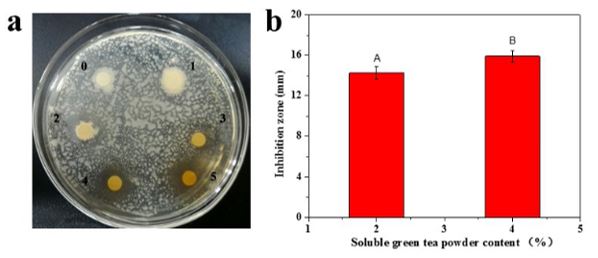
Conclusion
Tea oil nanoemulsion with different content of SGTP was prepared by low energy method, and the effect
of SGTP on the antioxidation and bacteriostasis of tea tree seed oil nanoemulsion was studied. The total
antioxidant capacity of the tea oil/SGTP nanoemulsion increased as SGTP concentration improved.
Additionally, Escherichia coli and Staphylococcus aureus can be suppressed in presence of tea tree seed oil/
SGTP nanoemulsion. Fabrication of tea tree seed oil/SGTP nanoemulsion expanded the applied filed of
SGTP and tea tree seed oil as the confirmed functions, such as anti-oxidation and bacteriostatic properties,
which also has potential in market of functional food.
Bibliography

Hi!
We're here to answer your questions!
Send us a message via Whatsapp, and we'll reply the moment we're available!